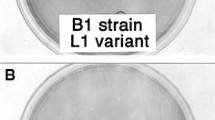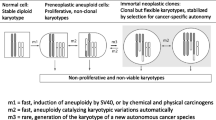Summary
A quantitativein vitro assay for the transformation of primate cells by PARA (defective SV 40)-adenovirus type 7 has been developed which allows comparison of the suceptibility of primate and rodent cells to PARA transformation. Transformation by PARA followed one-hit kinetics with a ratio of 12,500 plaque forming units of virus for each focus forming unit in the most efficient primate system tested. The ratio of plaque forming units to focus forming units in hamster embryo fibroblasts using the same virus stock was 2500∶1. The ability to quantitatively determine the transforming capacity of PARA depended upon the strain of PARA-adenovirus 7 employed and the cell type transformed. Single foci were isolated and characterized with respect to morphology and antigenicity. All were composed of cells with a morphology consistent with SV 40 transformation and contained SV 40-induced antigenic determinants. None contained detectable adeno virus specific antigens. Transformation did not alter the characteristic of the cells with respect to the ability to support the replication of various viruses.
Similar content being viewed by others
References
Black, P. H.: Transformation of mouse cell line 3T3 by SV 40: Dose response relationship and correlation with SV 40 tumor antigen production. Virology28, 760–763 (1966).
Black, P. H., andB. J. White:In vitro transformation by the adenovirus-SV 40 hybrid viruses. II. Characteristics of the transformation of hamster cells by the adeno 2-, adeno 3-, and adeno 12-SV 40 viruses. J. exp. Med.125, 629–646 (1967).
Boeyé, A., J. L. Melnick, andF. Rapp: Adenovirus-SV 40 “hybrids”: Plaque purification into lines in which the determinant for the SV 40 tumor antigen is lost or retained. Virology26, 511–512 (1965).
Butel, J. S., M. J. Guentzel, andF. Rapp: Variants of defective simian papova-virus 40 (PARA) characterized by cytoplasmic localization of simian papovavirus 40 tumor antigen. J. Virol.4, 632–641 (1969).
Butel, J. S., J. L. Melnick, andF. Rapp: Detection of biologically active adeno-virions unable to plaque in human cells. J. Bact.92, 433–438 (1966).
Butel, J. S., andF. Rapp: Replication in simian cells of defective viruses in an SV 40-adenovirus “hybrid” population. J. Bact.91, 278–284 (1966).
Butel, J. S., L. S. Richardson, andJ. L. Melnick: Variation in properties of SV 40-transformed simian cell lines detected by superinfection with SV 40 and human adenoviruses. Virology46, 844–855 (1971).
Casto, B. C.: Adenovirus transformation of hamster embryo cells. J. Virol.2, 376–383 (1968).
Duff, R., andF. Rapp: Quantitative characteristics of the transformation of hamster cells by PARA (defective simian virus 40)-adenovirus 7. J. Virol.5, 568–577 (1970).
Duff, R., F. Rapp, andJ. S. Butel: Transformation of hamster cells by variants of PARA-adenovirus 7 able to induce SV 40 tumor antigen in the cytoplasm. Virology42, 273–275 (1970).
Feldman, L. A., J. S. Butel, andF. Rapp: Interaction of a simian papovavirus and adenoviruses. I. Induction of adenovirus tumor antigen during abortive infection of simian cells. J. Bact.91, 813–818 (1966).
Huebner, R. J., R. M. Chanock, B. A. Rubin, andM. J. Casey: Induction by adenovirus type 7 of tumors in hamsters having the antigenic characteristics of SV 40 virus. Proc. nat. Acad. Sci. (Wash.)52, 1333–1340 (1964).
Jensen, F. C., andH. Koprowski: Absence of repressor in SV 40-transformed cells. Virology37, 687–690 (1969).
Jerkofsky, M. A., andF. Rapp: Cell-mediated complementation of human adenoviruses by simian papovavirus. Proc. Soc. exp. Biol. (N.Y.)132, 987–992 (1969).
Jerkofsky, M. A., andF. Rapp: Replication and complementation of human adenoviruses and simian papovavirus at an elevated temperature. J. Virol.2, 670–677 (1968).
McAllister, R. M., andI. Macpherson: Transformation of a hamster cell line by adenovirus type 12. J. gen. Virol.2, 99–106 (1968).
Melnick, J. L., S. E. Stinebaugh, andF. Rapp: Incomplete simian papovavirus SV 40. Formation of non-infectious viral antigen in the presence of fluorouracil. J. exp. Med.119, 313–326 (1964).
Rapp, F.: Dependence and complementation among animal viruses containing deoxyribonucleic acids. Symposium for the Society of General Microbiology18, 273–293 (1968).
Rapp, F.: The PARA-adenoviruses. In: Progress in Experimental Tumor Research, Vol. 16: Oncogenic Viruses, in press, 1972.
Rapp, F., J. S. Butel, L. A. Feldman, T. Kitahara, andJ. L. Melnick: Differential effects of inhibitors on the steps leading to the formation of SV 40 tumor and virus antigens. J. exp. Med.121, 935–944 (1965).
Rapp, F., andR. Duff: Quantitative aspects of virus-induced transformation of mammalian cells. In: From Molecules to Man. The Gustav Stern Symposium on Perspectives in Virology VII, pp. 37–53, New York and London: Academic Press, 1971.
Rapp, F., S. Pauluzzi, andJ. S. Butel: Variation in properties of plaque progeny of PARA (defective simian papovavirus 40)-adenovirus 7. J. Virol.4, 626–631 (1969).
Rapp, F., andS. C. Trulock: Susceptibility to superinfection of simian cells transformed by SV 40. Virology40, 961–970 (1970).
Shiroki, K., andH. Shimojo: Transformation of green monkey kidney cells by SV 40 genome. The establishment of transformed cell lines and the replication of human adenoviruses and SV 40 in transformed cells. Virology45, 163–171 (1971).
Stinebaugh, S., andJ. L. Melnick: Plaque formation by vacuolating virus, SV 40. Virology16, 348–350 (1962).
Tevethia, S. S., M. Katz, andF. Rapp: New surface antigen in cells transformed by simian papovavirus SV 40. Proc. Soc. exp. Biol. (N.Y.)119, 896–901 (1965).
Author information
Authors and Affiliations
Rights and permissions
About this article
Cite this article
Layne, S.S., Duff, R. & Rapp, F. Quantitative transformation of primate cells by PARA (defective SV40)-adenovirus type 7. Archiv f Virusforschung 39, 74–82 (1972). https://doi.org/10.1007/BF01241530
Received:
Issue Date:
DOI: https://doi.org/10.1007/BF01241530




